In the course of his teaching at the Institute of Science and Theology of Religion at the Institut Catholique de Paris, Sulpician Father de La Hougue collaborates regularly with the Institute of Theology at the main mosque in Paris. From February 20-27, 2011 he was invited by the Mosque of Paris to participate in a delegation to visit the holy sites of Shiite Islam in Iraq, to meet the main religious and political leaders of the four great schools of Shiite Islam in Iraq, the marja ‘iyya al-Hakim, and to pay homage to the dead Christians who were assassinated at the Church of Perpetual Help in Baghdad. Fr. De La Hougue, who speaks Arabic and teaches courses on Islam, briefly summarizes here three principal elements of his journey.
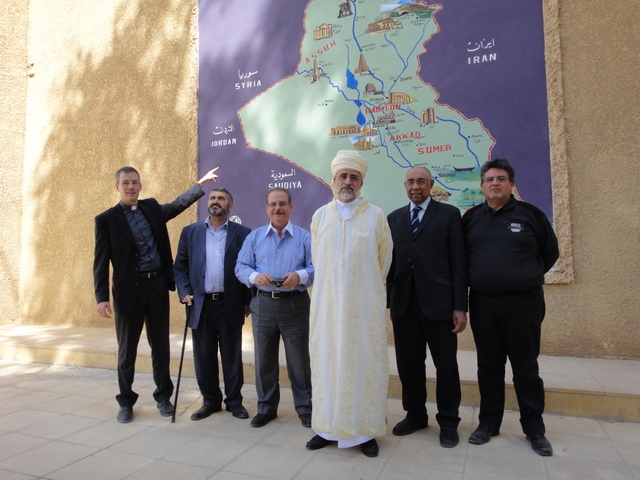 The delegation at Babylon in front of a map of Iraq
The delegation at Babylon in front of a map of Iraq
The Visit to the Holy Shiite Sites
The duodecimal Shiites think that Ali, cousin and son-in-law of Muhammad, and one of his 11 descendants, received from God a specific charism to spiritually guide the Muslim community. This charism has not been recognized by the majority of Muslims, the Sunni, who have been in armed conflict with them since the beginning of Islam. In this vein, Ali was assassinated in 661 and his son Hussein in 680 at Kerbala. Shiite spirituality is very marked by the martyrdom of the 12 imams(the 12 not being deceased but hidden until they appear at the end of time) and the Shiites gather en masse at Najaf and Kerbala, where they commemorate the martyrdom of Ali, Hussein and Abbas, half brother of Hussein.
Najaf
Najaf is some distance from the ruins of ancient Babylon. It is a place which Muslims call Wadi Salaam or Wadi Kiddush, the Valley of Peace or the Holy Valley, because according to Muslim tradition it was here that Adam, Eve, Noah, Abraham, and other Koranic prophets passed through. After our arrival, we first had a moving visit to the tomb of Ali with crowds of families and pilgrims which reminded us somewhat of the crowds at Christian sanctuaries, like Lourdes or Fatima. With our host, Sayyid al-Hakim, we took time to listen to the devotional prayers of the pilgrims and then to go and touch the tomb. Thousands of pilgrims were singing invocations in sorrowful memory of the Imams, and many Iranians strike their chest in a symbolic sign of flagellation to be close to the martyrdom of the Imams. All of these devotions are very impressive; one senses a great atmosphere of prayer. One can also witness scenes of people going in circles three times around the sanctuary before entering to in tomb to bury their dead. Many people who die at a considerable distance come here to be entombed in this holy city.
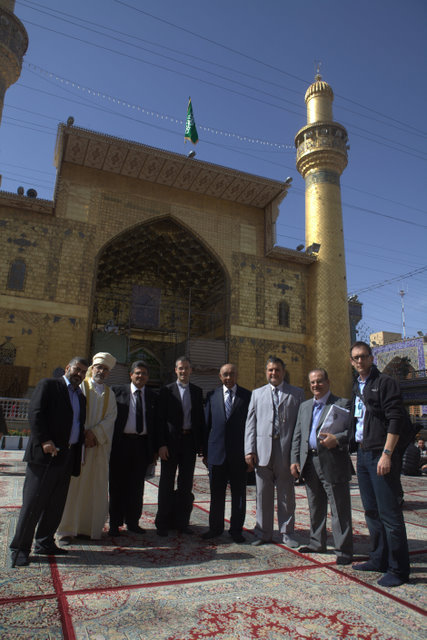 The Delegation before the Mosque of Ali at Najaf
The Delegation before the Mosque of Ali at NajafKerbala
At Kerala there are two large mosques at the heart of which are the tombs of Hussein and Abbas. Abbas is the intercessor to whom one confides all difficult causes, such as sickness, inability to have children, etc. There is a great deal of popular piety and a number of miracles associated with this place, like at Lourdes.
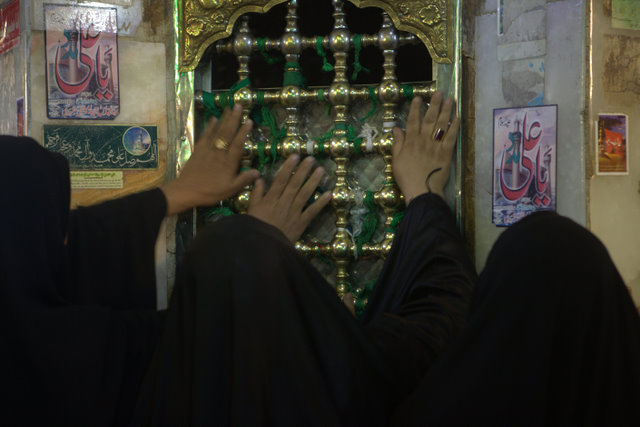 Devotion before the Mosque of Abbas at Kerbala
Devotion before the Mosque of Abbas at Kerbala
At the sanctuary of Hussein, one is immediately impressed by the place. The interior court is covered with a superb ceiling of Iranian motifs in ceramic. It is magnificent. On entering, one hears the recitation of the tales about the death of Hussein, everyone joins in crying out and making exclamations, during pauses in the narrative. Certain groups strike their chest and shout out cries or pleas, all of which is done to a striking rhythm. We then met at the tomb where I joined my Muslim companions for special invocations to Hussein: a prayer of thanksgiving for the goodness of God who is manifested by the Imam Hussein. Before entering the place of the tomb one recites a series of invocations, then one approaches the tomb and begins a second series, and then one touches the tomb.... Some people are in tears, others are moaning, and others touched the tomb without saying anything... A little bit farther away, we take up a second series of invocations. Then I was seated next to my companions who began their ritual prayer. I recite the tasbih (Islamic rosary) in the following manner: 33 times “thank you Lord," 33 times “forgive me Lord," and 33 times “glory to the Lord." I recite numerous prayers to thank the Lord for having given me the experience of this communion with my Muslim friends. At the end one of the two s says that he made a special prayer for me. We then leave in a quiet atmosphere and, as we leave, we notice groups arriving and singing again the tale of the martyrdom of Hussein....these pilgrims from Saudi Arabia.
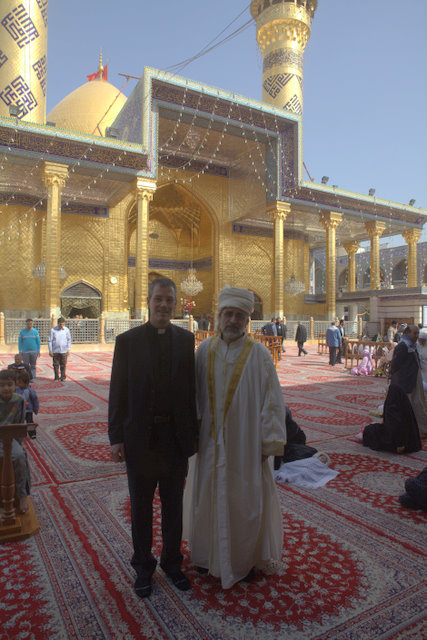 Fr. de La Hougue and Dr. Djelloul Seddiki, director of the Institute for Theology and the principal Mosque of Paris, in Kerbala
Fr. de La Hougue and Dr. Djelloul Seddiki, director of the Institute for Theology and the principal Mosque of Paris, in KerbalaVisit to the Shiite religious authorities
We had numerous meetings with Shiite religious authorities and, notably, with one of the four main spiritual leaders (marja’) of the Shiites in Iraq, Marja’ al-Hakim. He recalled for us the fundamental principle of the separation between the spiritual and temporal; these leaders prefer not to meddle in politics. This is the standard doctrine of the leaders in Iraq, in contrast to the present school of thought in Iran, seen primarily in Ali Khamenei for whom religious Iraqis don’t really have a lot of sympathy. We also met with a number of scholars at universities, attending courses, visiting libraries, and entering into discussions with the sheiks in a very free manner. The climate of freedom and confidence was quite impressive. Sayyid al-Hakim, who accompanied us the whole time, reminded me regularly that he wanted me to feel as if I was in France and that he was willing to respond to any question that I might post about Shiite Islam.
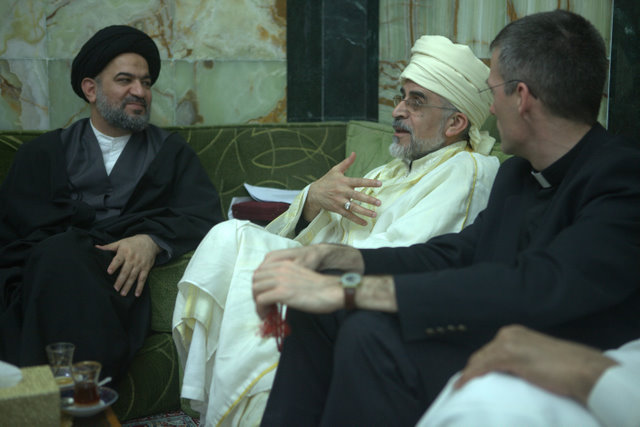 Dialogue
DialogueA visit to the Christians at the Church of Perpetual Help
We also had a moving visit to the Church of Perpetual Help where on October 31, 2010 the horrible attacks against Christians occurred. As of now the site is under intense protection, e. g., fire-proof walls, checkpoint, etc. The local priest who received us told us that when the terrorists arrived, the police who had regularly guarded the church had not been present for a week. The terrorists entered during mass, armed with grenades, machine guns, and belts of explosives. The priests who approached them to speak with them were immediately killed. Then the terrorists started to fire on everyone everywhere. Most of the parishioners fell to the floor trying to protect themselves behind the bodies of the dead. Several sought refuge in the sacristy where one of the terrorists came in and opened fire. They then made a ritual prayer of Maghreb and began to cause explosions at different points in the church. The whole attack lasted about four hours and the police did not intervene, which was absolutely not normal given the constant surveillance of the church beforehand. The local priest thought the attack was especially motivated by tribal conflicts. Abd al-Karim, an Iraqi who was part of our pilgrimage, thought the attack was orchestrated by certain secret Sunni services in the country who wanted to show the inability of the Shiites to ensure the security of minorities (knowing well that if Christians died, the whole world would talk about it, in contrast to attacks against Shiites who experience it regularly). We took time together for some prayer. The priest and I recited the Our Father in Arabic, the Muslims said a prayer for the dead and concluded with the fatiha. On Sunday I concelebrated mass with the community. Several of my Muslim friends joined me.
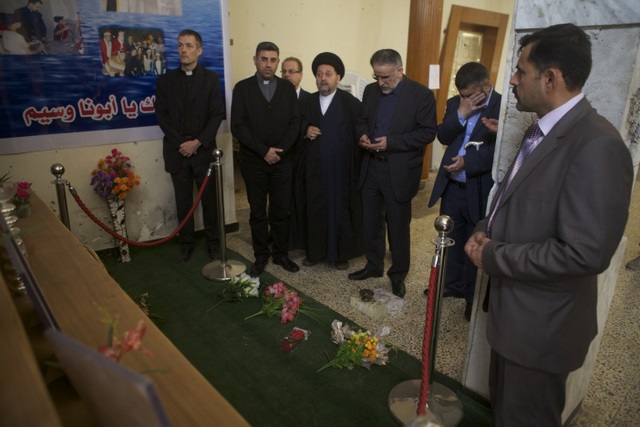 A Moment of Silence before the Portrait of the Assassinated Christians
A Moment of Silence before the Portrait of the Assassinated Christians